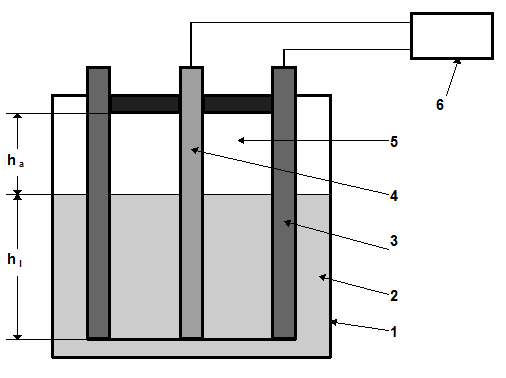Due to the difference in the dielectric constants of air and liquids, it is possible to measure level of liquids in tanks by measuring the change in the capacitance (measured between two coaxial cylinders partly immersed into the liquid) with liquid level. These devices can be used for level measurement of liquids at pressures up to 6 MPa.
If liquid is conductive, then cylinders (electrodes) are covered by an electrical insulation. Fig. shows a schematic view of a capacitance device for level measurements of liquids.

A tank 1 is filled with a liquid 2, which level is to be measured. Two electrodes (coaxial cylinders) 3 and 4 are immersed in this liquid. The value of capacitance for this device is determined by the two capacitances: that of the capacitor formed by the liquid and the electrodes, and the capacitor formed by air 5 and the electrodes.
A measuring device 6 then measures the variation in the capacitance. In this system, the increase in the total capacitance is directly proportional to the increase of the level. This technique is best applied to nonconductive liquids, since it is necessary to avoid the problems generated by conducting materials like acids.
For precision measurements an additional capacitance element is submerged in liquid to compensate for changes in the liquid characteristics.
Disadvantages of these devices are listed below:
- these devices are not able to measure level of liquids, which have tendency to crystallise, and of very viscous liquids;
- they are very sensitive to the variations of dielectric properties of liquids with process conditions and the variations of capacitances of connecting cables.
The range of level measurements varies from 1 to 20 m. The accuracy is equal to +/- 2.5%.
Article Source:: Dr. Alexander Badalyan, University of South Australia